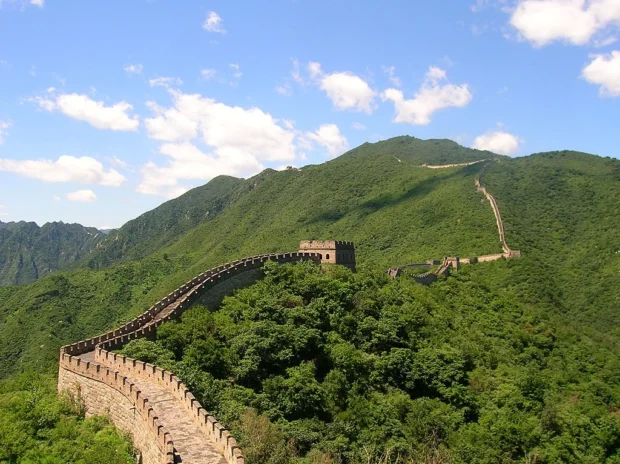Beholding the Great Wall of China from near Beijing unveils a striking chapter of human endeavor and defense, spanned across centuries. This travel guide covers key information about reaching the Great Wall from Beijing, insightful visitor advice, online reservations, and nearby conveniences to fully appreciate this iconic heritage site. Whether you start from the city center, airport, or train station, this summary aids your navigation and planning with precision.
Table of Contents
Reaching the Great Wall: Clear Routes and Transport Options
The Great Wall has several sections accessible from Beijing, with the most popular being Badaling, Mutianyu, and Jinshanling. These differ in ease of access, visitor density, and natural landscapes.
From Beijing City Center
Travelers can reach the Great Wall by public transport or private transfer. For superior convenience, consider booking a reliable shuttle or taxi. Public transport options include:
- Badaling: Take Metro Line 2 to Huangtudian Station, then Bus 877 directly to Badaling. Alternatively, Beijing North Railway Station offers a special train to Badaling.
- Mutianyu: Reach Huairou North Station via bus 916 or 916 Express from Dongzhimen; from there, take local buses or taxis for 10 km to Mutianyu.
- Jinshanling: Public transport is limited; better accessed through arranged tours or private cars from Beijing, approximately a 3-hour drive.
From Beijing Airports and Train Stations
At Beijing Capital International Airport or the newer Daxing International Airport, airport express trains and airport buses connect to city metro lines. From Beijing Railway Station or Beijing West Railway Station, metro lines 2, 4, and 7 facilitate transfers toward bus stations aligned with Great Wall access points. Optimizing your route with a city map app or a printed metro diagram enhances timing and comfort.
Visitor Tips: Best Time, Days, and Reservations
The Great Wall’s high altitude and exposure mean weather considerations are crucial. Spring (April to June) and autumn (September to November) present the most favorable conditions with crisp air and vivid natural colors.
- Weekdays over weekends: To avoid heavy crowds, plan visits during weekdays, especially early mornings when the wall is quieter.
- Early arrival: Arriving before 9 a.m. provides cooler temperatures and quieter paths.
- Clothing and gear: Wear sturdy shoes suitable for steep steps and irregular terrain. A hat and sunscreen are advisable even on cooler days.
- Reservations: Visitors must buy tickets to enter most parts of the Great Wall. These can be purchased in advance online or at entrance gates. For Mutianyu and Badaling, advance online booking is recommended during peak seasons.
Online ticketing and guided tours streamline your visit, avoiding queues. Mutianyu’s official website offers such services with clear tour options and ticket categories on their official page.
History and Cultural Role of the Great Wall Near Beijing
The Great Wall symbolizes China’s historical focus on border security and cultural preservation. Built and rebuilt through various dynasties, notably the Ming dynasty (1368–1644), the Beijing sections protected the capital from northern invasions. Its construction reflects advanced military architecture combining watchtowers, signal fires, and rugged pathways. The wall narrates tales of soldiers, engineers, and the common people who contributed to this monumental project.
A popular myth claims that the Great Wall is visible from space with the naked eye; however, astronauts clarify it is difficult to see without aid. This myth underlines the wall’s grandeur in popular imagination rather than physical reality.
Nearby Accommodation and Dining Options
Staying near the Great Wall can balance restful comfort and ease of access. Numerous guesthouses and inns in Huairou and Miyun districts offer local hospitality styles. While in these areas, tasting traditional northern Chinese cuisine enriches your visit.
Local specialties like Braised Duck, Beijing-style noodles, and wheat-based snacks are widely available. Village restaurants near Mutianyu serve hearty meals perfect for replenishing energy before or after your wall walk.
Planning Efficient Tours and Guided Experiences
Efficient tour planning integrates transport, ticketing, and timing. For visitors favoring flexibility, self-guided exploration suits Badaling and Mutianyu with adequate signage and visitor centers. Jinshanling’s ruggedness is ideal for hiking enthusiasts seeking tranquility.
Guided tours offer historical depth and little-known anecdotes, explaining architectural features and cultural contexts. Booking through agencies specializing in heritage tours ensures knowledgeable guides and well-coordinated transfers.
Booking and Tour Agencies
Online platforms provide multiple tour choices, ranging from half-day to multi-day options combining Great Wall visits with Beijing city highlights like the Forbidden City or the Summer Palace.
Visitors appreciating ancient fortifications will find the Forbidden City offers a rich contrast with its imperial architecture and historic grandeur in Beijing.
Use official resources for ticket purchasing and authentic experiences, minimizing risks of scams or poorly managed tours.
After exploring the Great Wall, strolling through the sacred grounds of the Temple of Heaven reveals another layer of Beijing’s rich history and spiritual culture.
Practical Accessibility and Visitor Flow Management
Several Great Wall segments have implemented measures to enhance accessibility and visitor control. Cable cars, chair lifts, and shuttle buses ease ascending steep sections, particularly in Mutianyu. Visitors with reduced mobility benefit from these facilities.
Early booking and off-peak visits contribute to smoother visitor flow and better enjoyment of the site’s vastness without congestion.
Respect for the site’s conservation rules ensures future generations can experience the wall’s historical atmosphere. Avoid littering, stay on designated paths, and follow guides’ instructions.
For a broader look at the city’s highlights beyond the Great Wall, check the section about Beijing’s famous landmarks and culture to plan what to visit next.
Uncommon Facts and Lesser-Known Details
Beyond the walls, look for inscriptions carved by soldiers, ancient steps covered with centuries-old moss, and small temples tucked in corners. These elements embody the human side of this imposing structure.
Some watchtowers exhibit distinctive brick colors and inscriptions dating from the Ming era, giving clues about the craftsmen’s origins and the wall’s evolving role over time.
Finally, the Great Wall near Beijing is not a single continuous ribbon but a network of linked fortifications adapting to terrain and threats, revealing ancient strategic ingenuity in its layout.

- Great Wall of China July 2006 by Velatrix on Wikimedia Commons – cc0
